Experimental Highlights - 2018
November
Discovery Science Strengthens NIF’s Mission
First of two articles describing the value of Discovery Science experiments to NIF.
The Discovery Science Program comprises just a fraction of NIF’s experiments, but it has spun off a wealth of benefits to the world’s largest and highest-energy laser system.
These basic science experiments feed NIF with an endless supply of creative ideas; help spotlight, improve, and validate innovative experiments; strengthen LLNL’s ties to the world’s scientific community; and attract the next generation of top talent to Livermore.
The benefits that arise from Discovery Science (DS) are “a fortunate side effect” of NIF’s ability “to do science that no one in the world can do,” says NIF Director Mark Herrmann. “Discovery Science helps us show the whole world that we’re at the top of our game.”
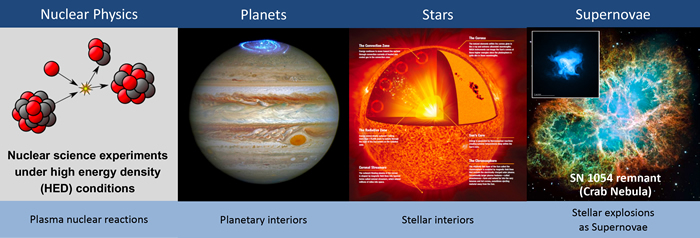 NIF’s versatility inspires Discovery Science Program ideas. Illustration: Mark Meamber
NIF’s versatility inspires Discovery Science Program ideas. Illustration: Mark Meamber Of approximately 400 NIF experiments each year, about 8 percent of shot time is set aside for DS. The bulk of the time, NIF uses its 192 laser beams to conduct high-energy laser experiments to support NNSA’s near-term stockpile stewardship goals, including inertial confinement fusion (ICF) research.
Yet NIF’s unique ability to push new boundaries in nuclear physics, plasma physics, materials science, and astrophysics inspires scientists to bring forth a bounty of ideas for unlocking the mysteries of the universe.
NIF receives far more DS proposals than it has time to grant. More than 30 teams proposed about 90 days’ worth of experiments last year, yet only 11 teams were allocated about 18 days’ worth of time. Still, even rejected proposals can stimulate scientific creativity that pays off down the line.
“The proposal process is when a lot of cool and sometimes crazy ideas get batted around,” says NIF & Photon Science plasma physicist Tammy Ma, “because nobody ever before has had 192 lasers, plus a really high-energy short-pulse laser, really great target fabrication capabilities, and such a suite of high-fidelity diagnostics.
“So people ask, what if we add a magnetic field, or what if we shoot lasers from this side or that side?” she says. “You get to be really innovative through the process, whether or not your proposal gets accepted. Nothing is too outlandish, as long as you don’t break the laser.”
If their proposal is accepted, the researchers get the opportunity to work with NIF scientists. “In that way, we get exposed to a lot of cool projects and new ideas,” Ma says. “It’s a lot of work, but where else would you get to probe the interior of Jupiter or make a supernova?”
Expanding Scientific Relationships
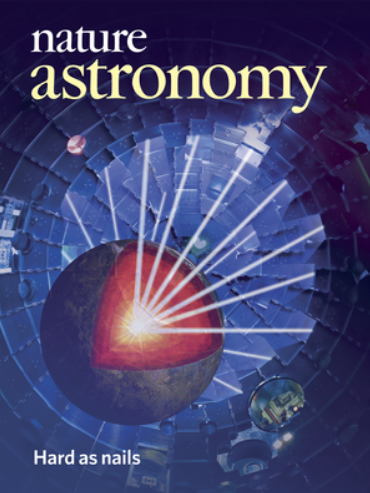 Cover of the June 2018 issue of Nature Astronomy. Credit (Image): Mark Meamber/LLNL. Cover Design: Bethany Vukomanovic
Cover of the June 2018 issue of Nature Astronomy. Credit (Image): Mark Meamber/LLNL. Cover Design: Bethany Vukomanovic The results can be groundbreaking. One recent example that caught the scientific community’s attention was a series of five experiments, conducted at NIF in conjunction with a multi-institutional team of international researchers, that demonstrated how hydrogen becomes metallic in the interiors of Jupiter, Saturn, and extra-solar planets. Their paper was published in Science in August.
In another recent example, a team of researchers from LLNL, Princeton University, Johns Hopkins University, and the University of Rochester published a cover article in Nature Astronomy showing the compression of iron could provide insights into the conditions at the core of large Earth-like exoplanets.
And an extensive, 112-page article entitled “Dynamic HED plasma environments at NIF for nuclear science research” published in February in Journal of Physics G: Nuclear and Particle Physics discussed the unique regimes of nuclear science accessible on NIF for basic nuclear physics, astrophysics, and program-oriented science.
When published in prestigious journals, such research gives NIF scientists a public spotlight on their accomplishments that they might not have when doing classified research. The quality of work the Lab can talk about indicates the quality of work it can’t talk about.
“The highest payoff is the visibility that it gives to this style of science on a big laser,” says Discovery Science Program Leader Bruce Remington.
That sends a powerful message to America’s allies and adversaries.
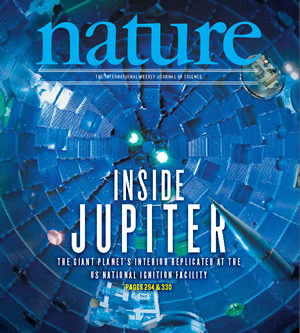 A July 2014 cover story in Nature detailed NIF experiments peering into giant planets.
A July 2014 cover story in Nature detailed NIF experiments peering into giant planets. “When we can publish articles in these prestigious journals, which isn’t possible for all of our research, they are seen by all the scientists in the world,” Herrmann says. “These publications show that we have great scientists working at our laboratories and that we’re very serious about our nuclear deterrent research. If we’re doing great science on iron, it’s a good bet that we’ re doing great science on plutonium.”
Broader Peer Review
Discovery Science also helps keep Lab scientists out of a potential feedback loop caused by the shallower pool of peer reviewers who have access to classified work.
“It’s certainly true that science is not a solitary experience,” says physicist Jon Eggert, group leader with the Dynamic Materials Properties Group. “By publishing in open journals, you get a much broader range of scientists with different interests, which then brings up shortfalls in what you’ve been doing,” he says. “You also get to talk to people at conferences. That’s a form of peer review—the comments when we present our work or even informal conversations with other scientists.”
That feedback has led Lab scientists change tactics. For example, a 2014 paper published in Nature by researchers from LLNL, the University of California at Berkeley, and Princeton University examined the compression of diamond to up to five terapascals, about 50 million times ambient air pressure.
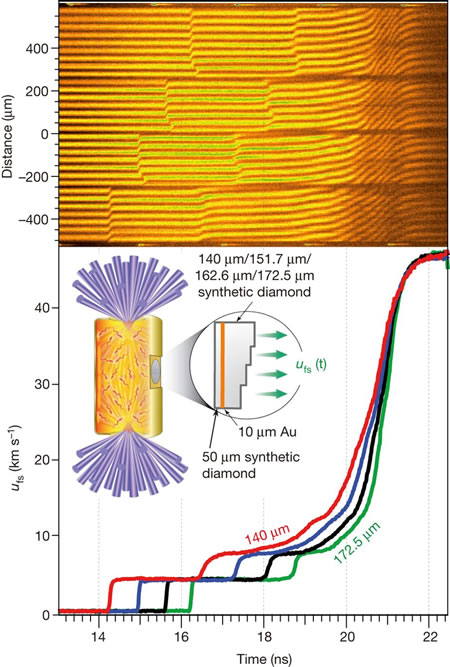 A graphic from a 2014 Nature paper records NIF Discovery Science experiments, as ablative pressure waves compress nanocrystalline diamond samples inside a hohlrahm (inset) over about 22 nanoseconds (billionths of a second). The top shows a velocity interferometry record of the sample’s back surface response as it is engulfed by the wave, while the bottom charts four different thicknesses of the sample.
A graphic from a 2014 Nature paper records NIF Discovery Science experiments, as ablative pressure waves compress nanocrystalline diamond samples inside a hohlrahm (inset) over about 22 nanoseconds (billionths of a second). The top shows a velocity interferometry record of the sample’s back surface response as it is engulfed by the wave, while the bottom charts four different thicknesses of the sample. For equation of state (EOS) experiments, scientists also believed diamond “was going to be a great ablator,” Eggert says. “We found that it didn’t work very well.”
While compressing the material under very high pressures reduced reverberations, scientists couldn’t completely get rid of them, Eggert says. But through peer review of the well-received EOS of diamonds paper and discussions with other scientists at conferences, “our thinking actually did change,” he says.
“We decided to go away from diamonds and to copper ablators for EOS experiments,” Eggert says. “That’s what we’re using now.” Diamond remains a promising ablator for NIF ICF experiments.
The outside feedback NIF receives from DS experiments helps Lab researchers correctly craft and interpret data from classified experiments.
“We want to be right, because if we’re making the wrong conclusions about experimental data, that could lead the weapons program to make wrong conclusions about something important for the stewardship program,” Herrmann says.
Additionally, NIF wants to keep up with the latest scientific knowledge.
“We want to maintain our edge,” Herrmann says. “We want to make sure we aren’t surprised, that someone doesn’t come by and scoop us.”
Science Advocates
Outside researchers can also help advocate on behalf of the field of HED science. Members of the NIF User Group provide a channel of communication between management, users, funding agencies, and the public.
“Some of these Discovery Science projects really capture people’s imagination,” Ma says. “It helps us build a network of support.”
That network extends far beyond America’s borders. Ma is principal investigator of an international team developing an experimental proton acceleration platform, using NIF’s Advanced Radiographic Capability (ARC) to study extreme conditions found deep inside the planets and stars, enhance targeted tumor therapy, and advance the frontiers of high energy density (HED) science. The team includes researchers from the United Kingdom’s Oxford University and Rutherford Appleton Laboratory.
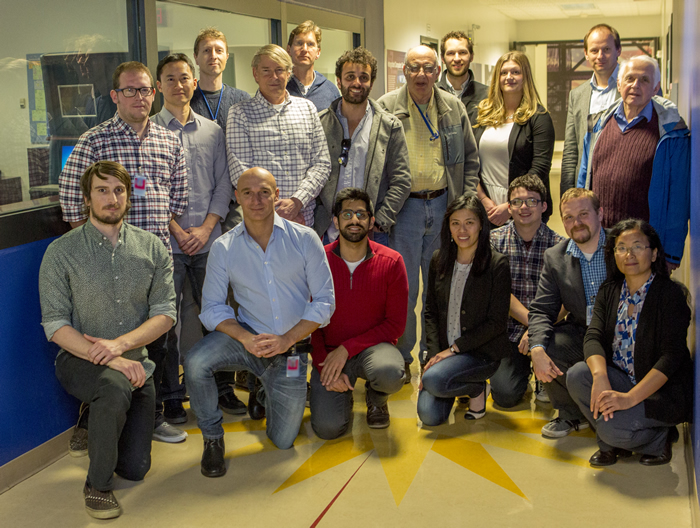 Members of the ARC proton acceleration team outside the NIF Control Room. Credit: Jason Laurea
Members of the ARC proton acceleration team outside the NIF Control Room. Credit: Jason Laurea The team also includes Japan’s Osaka University, which last year signed a memorandum of understanding with LLNL to conduct academic exchanges in basic science and technology.
“The idea is to build a strong bilateral relationship with our two countries through collaboration in science,” Ma says. “It’s another way we can be close allies outside of just the political or military arena. They come out for our shots, they help model our results, and we also go over to Osaka University to do preparatory precursor experiments at their LFEX (Laser for Fast Ignition Experiments).”
She adds that these collaborations are a great way to stay grounded and involved in the science that the outside world cares about. “The other cool thing is it trains you to be creative,” Ma says. “Then you take that over to the other work that we do. It trains you to find new solutions.”
Outside researchers also benefit from the intense competition for the few available DS slots on NIF.
More Than Lasers
“The process helps to make our proposals better,” says Raymond Jeanloz, professor of Earth and Planetary Science & Astronomy at the University of California, Berkeley. “It makes us better as well. It forces us to think long and hard about what is the best science we can do.”
And it’s not just about the building or the technology.
“What makes a difference in the end is the people we interact with,” Jeanloz says. “It’s not just the hardware. It’s world-class scientists, engineers, technical staff, and the broader scientific community. We get to interact with some fantastic people.”
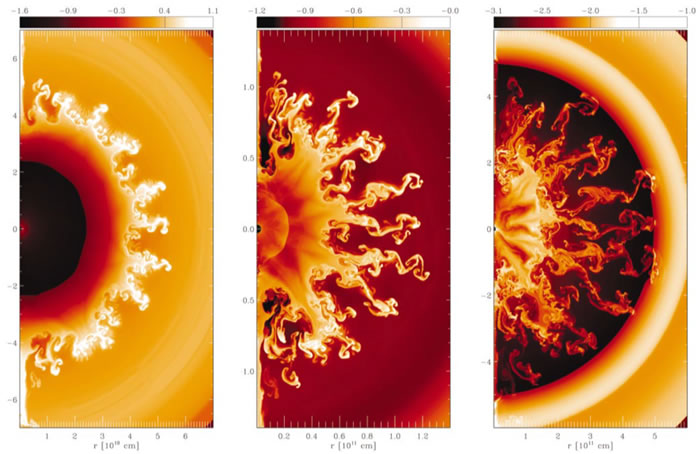 University of Michigan researcher Carolyn Kuranz is doing experiments on NIF to test whether there are radiative effects left out of supernova simulations, such as this 2003 simulation from Konstantinos Kifonidis and other scientists from the Max Planck Institute for Astrophysics.
University of Michigan researcher Carolyn Kuranz is doing experiments on NIF to test whether there are radiative effects left out of supernova simulations, such as this 2003 simulation from Konstantinos Kifonidis and other scientists from the Max Planck Institute for Astrophysics. For Carolyn Kuranz, director of the Center for Laser Experimental Astrophysics Research at the University of Michigan, NIF is a unique venue for her work exploring the dynamics of an exploding supernova.
“There’s no single university that could ever independently build or support a facility like NIF,” says Kuranz, a research associate professor in climate, space science, and engineering. “Even something on a much, much smaller scale would be challenging.
“Having access to the world’s largest laser really enhances my research program and the work that I can do,” she adds. “It raises that to a level of visibility that I don’t think I would have otherwise because of the visibility of NIF itself.”
A Great Place to Work
DS experiments also help advance the careers of current NIF scientists.
“If they’re going to be recognized as a world-class expert in a certain area, they have to engage with the outside world,” Herrmann says. “If they only do classified research, fewer people will know how good they are.”
 LLNL Physics staff members Marius Millot, Federica Coppari, and Dayne Fratanduono observe a diamond anvil cell similar to the ones used for their recent discovery of superionic water ice. Credit: Jason Laurea
LLNL Physics staff members Marius Millot, Federica Coppari, and Dayne Fratanduono observe a diamond anvil cell similar to the ones used for their recent discovery of superionic water ice. Credit: Jason Laurea Finally, DS helps fill the pipeline with job candidates once they get a taste of what it’s like to work at the Lab.
“The Lab can be an intimidating place,” Herrmann says. “You come here and there are armed guards. It’s not like a university. If you’re a student, you’re looking at this place wondering what’s it like on the inside.”
DS “breaks down those barriers tremendously,” he says, “because the students who come here and work on this (research) get to see that the scientists working day-to-day are a lot like the scientists they work with at the universities.
“Some people think this program is mainly about the benefits the outside folks get,” Herrmann says. “Actually, it’s more important for us than it is for the outside folks, in terms of how we attract people, how we retain them, and how we develop them.”
—Benny Evangelista
NEXT: The Discovery Science Program has helped equip NIF with novel state-of-the-art diagnostic tools.
Follow us on Twitter: @lasers_llnl




